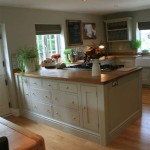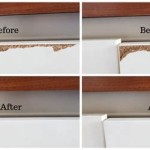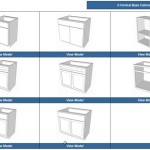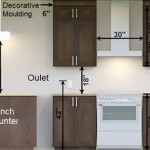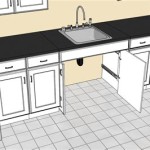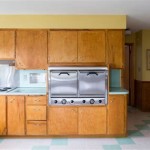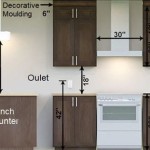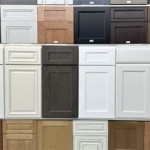Formica Kitchen Cabinets: A Comprehensive Guide
Formica kitchen cabinets, a staple in both residential and commercial spaces for decades, have a long and storied history. Initially developed as a substitute for mica insulation in electrical applications, Formica's durable and versatile properties quickly led to its adoption in furniture and, eventually, kitchen cabinetry. This material offers a unique blend of affordability, resilience, and aesthetic flexibility, making it a popular choice for homeowners and designers alike. Understanding the composition, advantages, disadvantages, and maintenance requirements of Formica cabinets is crucial for making informed decisions regarding kitchen remodeling or new construction projects.
Formica, technically a brand name, has become synonymous with high-pressure laminate (HPL). HPL is manufactured by bonding multiple layers of kraft paper saturated with phenolic resin under high heat and pressure. A decorative layer, often printed with a design or color, is then applied and covered with a clear melamine resin. This process results in a sheet of durable, non-porous material that can be adhered to various substrates like particleboard, MDF (medium-density fiberboard), or plywood. The substrate provides the structural integrity of the cabinet, while the Formica laminate provides the surface finish.
The selection of the substrate is a critical factor influencing the overall quality and performance of Formica kitchen cabinets. Particleboard, the most economical option, is susceptible to moisture damage and may sag over time if not properly supported. MDF, a denser and more stable engineered wood product, offers better resistance to moisture and warping. Plywood, known for its strength and durability, is often considered the premium substrate for Formica cabinets, providing long-lasting performance and resistance to the stresses of everyday use.
The aesthetic options available with Formica are extensive. A wide range of colors, patterns, and textures, including wood grain simulations, stone imitations, and solid colors, are readily available. This versatility allows homeowners to create kitchen designs that range from classic and traditional to modern and contemporary. Furthermore, Formica can be fabricated with various edge details, such as bullnose, beveled, or square edges, to further customize the appearance of the cabinets.
Durability and Resistance
One of the primary reasons for the enduring popularity of Formica kitchen cabinets is their exceptional durability. The melamine resin surface is inherently scratch-resistant, stain-resistant, and easy to clean. This makes Formica cabinets well-suited for the demands of a busy kitchen environment where spills and splatters are common occurrences. Unlike painted or stained wood cabinets, Formica does not require frequent refinishing or sealing. A simple wipe-down with a damp cloth is typically sufficient to maintain a clean and attractive surface.
The non-porous nature of Formica also provides excellent resistance to bacteria and mold growth. This is particularly important in areas prone to moisture, such as around sinks and dishwashers. The hygienic properties of Formica make it a suitable choice for homeowners concerned about maintaining a healthy and clean kitchen environment. While not completely impervious to water damage, Formica offers significantly better moisture resistance than solid wood or veneer cabinets, especially when properly sealed at the edges and seams.
However, it's important to note that the durability of Formica cabinets is dependent on the quality of the substrate and the edge banding. Particleboard substrates are particularly vulnerable to water damage, causing swelling and delamination of the Formica laminate. Edge banding, which seals the exposed edges of the substrate, is crucial for preventing moisture intrusion. Poorly applied or damaged edge banding can compromise the integrity of the entire cabinet.
Cost-Effectiveness
Formica kitchen cabinets are generally more affordable than solid wood cabinets, making them an attractive option for budget-conscious homeowners. The cost savings can be substantial, especially when considering large kitchens with numerous cabinets. The lower material cost of Formica and engineered wood substrates, coupled with efficient manufacturing processes, contribute to the overall affordability of these cabinets. This allows homeowners to allocate resources to other aspects of the kitchen renovation, such as countertops, appliances, or flooring.
The long-term cost-effectiveness of Formica cabinets should also be considered. Due to their durability and low maintenance requirements, Formica cabinets can provide years of reliable service with minimal upkeep. This can result in significant savings over the lifespan of the cabinets compared to materials that require frequent refinishing or replacement. While the initial investment in Formica cabinets may be higher than alternative options like thermofoil, the durability and longevity of Formica can often justify the higher upfront cost.
However, it is crucial to differentiate between various grades and qualities of Formica and substrates. Lower-quality Formica and inferior substrates, such as thin particleboard, may offer a lower initial price but can result in premature wear and tear, leading to higher replacement costs in the long run. Investing in high-quality Formica and a durable substrate, such as MDF or plywood, is a worthwhile investment that can ensure the longevity and performance of the cabinets.
Design and Style Considerations
The versatility of Formica allows for a wide range of design and style options in the kitchen. The availability of numerous colors, patterns, and textures enables homeowners to create kitchens that reflect their personal tastes and preferences. Formica can be used to achieve a variety of looks, from sleek and modern designs to more traditional and rustic styles. The ability to simulate wood grains, stone patterns, and other materials provides designers with a high degree of creative freedom.
The edge details of Formica cabinets can also significantly impact the overall aesthetic. Rounded or bullnose edges provide a softer, more traditional look, while square or beveled edges offer a cleaner, more contemporary appearance. The choice of edge detail should complement the overall style of the kitchen and the design of the cabinet doors and hardware. Seamless edge banding, which eliminates visible seams, can further enhance the visual appeal of Formica cabinets.
While Formica offers a wide range of aesthetic options, it is important to be aware of its limitations. Formica is a flat surface material and cannot be easily shaped or carved like solid wood. This limits the ability to create intricate details or raised panel designs. However, this limitation can be overcome by incorporating decorative hardware, moldings, and other design elements to add visual interest and character to the kitchen.
The color and pattern choices for Formica cabinets should be carefully considered in relation to the overall kitchen design. Lighter colors can help to brighten a small or dark kitchen, while darker colors can create a more dramatic and sophisticated look. The pattern of the Formica should also be chosen to complement the other elements in the kitchen, such as the countertops, backsplash, and flooring. Avoid using overly busy or distracting patterns, as they can overwhelm the space.
Maintaining Formica kitchen cabinets is straightforward. Regular cleaning with a damp cloth and mild detergent is typically sufficient to remove dirt and grime. Abrasive cleaners and scouring pads should be avoided, as they can scratch and damage the surface. For stubborn stains, a paste of baking soda and water can be used as a gentle abrasive cleaner. It is also important to promptly wipe up spills to prevent staining or water damage.
The longevity of Formica kitchen cabinets can be extended through proper care and maintenance. Inspecting the edge banding regularly and repairing any damage promptly can prevent moisture intrusion and delamination of the Formica. Avoid placing hot pots and pans directly on the Formica surface, as this can cause discoloration or damage. Using cutting boards and trivets can help to protect the Formica from scratches and heat.
When evaluating Formica kitchen cabinets, it is essential to consider the reputation and experience of the manufacturer. Choosing a reputable manufacturer ensures that the cabinets are made with high-quality materials and construction techniques. Reading online reviews and seeking recommendations from other homeowners can help to identify reputable manufacturers. It is also important to inquire about the warranty and return policy of the manufacturer.
The installation of Formica kitchen cabinets should be performed by experienced professionals. Proper installation is crucial for ensuring the longevity and performance of the cabinets. Professional installers have the knowledge and tools necessary to install the cabinets correctly, ensuring that they are level, plumb, and securely attached to the walls. Improper installation can lead to sagging, warping, and other problems that can compromise the integrity of the cabinets.
Formica kitchen cabinets remain a viable and popular choice for homeowners seeking an affordable, durable, and aesthetically versatile option. By understanding the composition, advantages, disadvantages, and maintenance requirements of Formica cabinets, informed decisions can be made regarding kitchen renovation or new construction projects. The proper selection of materials, careful attention to design details, and professional installation are essential for maximizing the longevity and performance of Formica kitchen cabinets.

Contemporary Kitchen

White Cabinets

Nice White Cabinets And Formica Laminate Kitchen By Apex Kitchens We Re In Love With That Geometric Backs Cabinet Design

Formica

Formica Granite Or Quartz Which Option Is Best For Your Kitchen Counter

Lacquer Wood Mixing Modern Gallery Oak White Formica Kitchen Laminate Pantry Cabinets China Melamine Made In Com

Why Use Fenix Laminate Sheets For Your Luxury Kitchen Cabinets Formica

Trends In Kitchen Design

How To Refinish Your Kitchen Cabinets

How To Choose Laminates For Kitchen Cabinets
Related Posts

